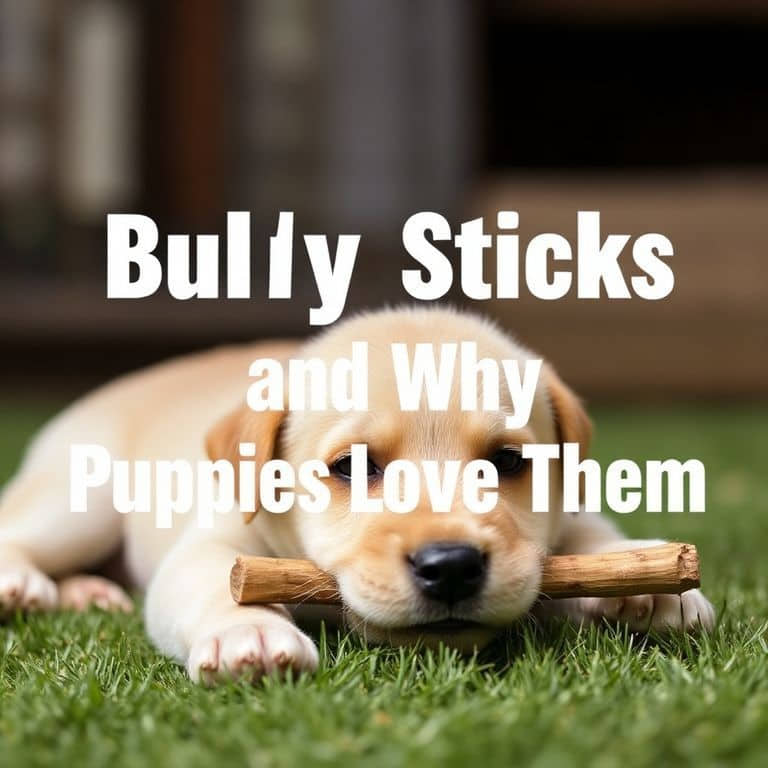You walk into the room, and there’s your puppy, proudly gnawing on the corner of your favorite coffee table. You sigh. They’re not being bad—they’re just being a puppy. But how do you channel that relentless chewing energy into something safe and productive?
Enter bully sticks. These natural chews have become a go-to for many dog owners, promising hours of contented chewing. But are they safe for your puppy? Let’s explore everything you need to know, from benefits and risks to smarter choices and creative alternatives.
What Are Bully Sticks and Why Do Puppies Love Them?
At first glance, a bully stick might look like a piece of beef jerky. In reality, it’s a single-ingredient chew made from dried cattle pizzle (yes, that part). What sets bully sticks apart from other chew options is their simplicity and natural appeal.
Here’s why puppies (and owners) love them:
- Pure and Simple: No fillers, artificial additives, or unpronounceable ingredients—just beef.
- Satisfyingly Chewy: Tough enough to keep puppies engaged but not so hard that it risks their developing teeth.
- Variety for All Sizes: Whether your pup is the tiniest Chihuahua or a growing Labrador, there’s a bully stick size and thickness to match their needs.
Can Puppies Have Bully Sticks? Let’s Break It Down by Age
Not all puppies are ready for bully sticks. Their safety depends on age, size, and how you introduce the chew.
Under Three Months
Too young. Puppies at this stage are still developing their digestive systems and teeth. Opt for softer teething toys or frozen washcloths instead.
Three to Six Months
This is the teething phase. Softer, thinner pizzle sticks designed for puppies can provide relief, but supervision is essential. Monitor for any signs of digestive upset or attempts to swallow large pieces.
Six Months and Older
Most puppies can safely enjoy regular-sized bull sticks by this age. Choose a stick that’s longer than your puppy’s muzzle and appropriately thick for their chewing strength.
The Benefits of Bully Sticks: Why They’re a Win for Puppies
- Teething Relief: Imagine the discomfort of erupting teeth. Bully sticks act like a satisfying massage for sore gums, offering relief during those pesky teething months.
- Cleaner Teeth, Fresher Breath: As your puppy chews, the stick scrapes away plaque and tartar, contributing to better oral hygiene.
- Behavioral Balance: Chewing is more than a pastime for puppies—it’s instinctive. A good chew like a bully stick keeps them focused and reduces destructive behaviors.
Potential Risks and How to Tackle Them
1. Choking Hazards
- The Problem: Puppies might try to swallow a bully stick fragment that’s too small.
- The Solution: Supervision is non-negotiable. Use a bully stick holder to secure the chew and remove it when it becomes small enough to fit in their mouth.
2. Digestive Sensitivities
- The Problem: Overindulgence or intolerance to the protein in pizzle sticks can lead to diarrhea or vomiting.
- The Solution: Start slow. Limit chewing to 15–20 minutes per session and monitor your puppy’s reaction.
3. Bacterial Contamination
- The Problem: Bull sticks are natural products and can harbor bacteria like Salmonella if not handled properly.
- The Solution: Reputable manufacturers test their products for bacteria, so prioritize quality sourcing. Always wash your hands after handling bully sticks and store them in airtight containers to keep them fresh and safe.
4. Calorie Count
- The Problem: Did you know that a 6-inch bully stick can contain 70–100 calories? That’s a lot for a small pup!
- The Solution: Treat bully sticks as occasional indulgences. Balance their caloric intake by adjusting meal portions or consulting your veterinarian.
How to Choose the Right Bully Stick for Your Puppy
1. Size Matters:
- Small puppies: Look for 4–6-inch sticks.
- Medium to large puppies: Choose 8–12-inch sticks for longer chew sessions.
2. Softness for Teething: Puppies under six months benefit from thinner or braided sticks that are easier on sensitive gums.
3. Check the Label:
- Single Ingredient: Stick with 100% beef pizzle.
- Reputable Sources: Look for products made in the U.S., Brazil, or New Zealand, where safety standards are strict.
- Chemical-Free: Avoid sticks with preservatives or artificial flavors.
Alternatives to Bully Sticks
Bully sticks aren’t the only option for chewing. Here’s how other choices stack up:
1. Rubber Chew Toys
- Pros: Reusable, durable, and great for aggressive chewers.
- Cons: Doesn’t offer the edible satisfaction of bully sticks.
2. Rawhide
- Why Not?: Rawhide is a risky choice for puppies. It’s difficult to digest, often treated with chemicals, and poses a high risk of choking or gastrointestinal blockages. Most veterinarians strongly advise against it.
3. Antlers
- Pros: Extremely durable and long-lasting.
- Cons: Too hard for puppies, risking cracked or fractured teeth.
4. Frozen Carrots or Wet Washcloths
- Pros: Affordable and soothing for teething puppies.
- Cons: Short-lived and less engaging than bully sticks.
5. Vegetable-Based Chews
- Pros: Hypoallergenic and easily digestible.
- Cons: May not satisfy strong chewers for long.
Supervision and Storage: Making Bully Sticks Safer
- Keep an Eye on Chewing: Puppies should never be left alone with a bully stick. Remove the chew if they start breaking off large pieces.
- Time Limits: Limit chewing sessions to 15–20 minutes to prevent overconsumption.
- Proper Storage: Store bully sticks in an airtight container in a cool, dry place. Discard any sticks that appear moldy or have a strong odor.
Conclusion: Finding the Right Chew for Your Pup
Bully sticks are a fantastic tool for teething relief, behavioral management, and dental health—but they’re not perfect. Knowing the risks, choosing high-quality products, and supervising your puppy are key to ensuring safe and happy chewing.
Remember, every puppy is different. Start slow, observe their preferences and tolerances, and consult your veterinarian for tailored advice. Whether it’s a bully stick or a frozen carrot, the right chew can help your puppy grow into a happy, healthy companion.

